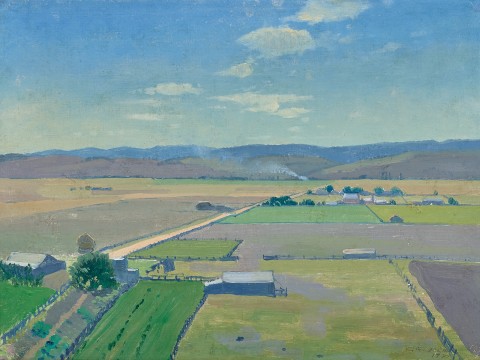VALLEY NEAR BAIRNSDALE, 1930
ELIOTH GRUNER
oil on canvas on board
30.0 x 40.5 cm
signed and dated lower right: GRUNER / 1930
signed, dated and inscribed with title verso: Valley near Bairnsdale/ E Gruner 1930
Elioth Gruner, Sydney (Artist’s Ledger no. 371)
Dr Robert Godsall, Sydney, by 1940
Thence by descent
Private collection, Sydney
Private collection, New South Wales
Private collection, Sydney
Elioth Gruner Memorial Loan Exhibition, National Art Gallery of New South Wales, Sydney, 17 April – 31 May 1940, cat. 159 (as ‘Landscape near Penrith’)
We are grateful to Steven Miller, Head of the Edmund and Joanna Capon Research Library and Archive, Art Gallery of New South Wales, for his assistance with this catalogue entry.
We are grateful to Deborah Clark for her assistance with this catalogue entry.
Elioth Gruner remains one of Australia’s most accomplished landscape painters. A child prodigy, he first started his art training at the age of twelve in 1894 with drawing classes run by Julian Ashton, before enrolling officially at the latter’s newly established Académie Julian two years later. A prodigious traveller, Gruner painted many remote parts of Australia, travelling by foot, train and horse-and-cart until the purchase of a car in 1928 opened up further vistas of opportunity. An extended visit to Europe from 1923 saw him introduce a mild form of modernism into his work; and Valley near Bairnsdale, 1930, is a fine example of this mature technique.
Gruner won the Wynne Prize for landscape a remarkable seven times, a record still unsurpassed; and his second win, Spring frost, 1919, remains one of the Art Gallery of New South Wales’ best loved pictures. What makes these early works notable is Gruner’s choice of painting into the light, leaving a diamond-like brilliance surrounding his central subjects. He travelled to Europe in 1923 and whilst there, encountered the artist Sir William Orpen who was not impressed by Gruner’s work. He nonetheless gave the Australian some salient advice that he took to heart, encouraging the use of smaller canvases and a thinner, more pastel-like application of paint. Gruner also studied paintings by Gauguin and Cézanne in London, which additionally caused him to make ‘a decisive turn towards structure and rhythm as core principles.’1 Following his return to Australia in 1925, Gruner’s landscapes became flatter and more ordered, though ‘he never shunned the iridescent nature of light, allowing its radiance to permeate and penetrate his landscapes.’2 All these elements are present in the harmonious construction of Valley near Bairnsdale, 1930 with its patchwork layout of orderly paddocks leading the eye to the low hills forming the southern extremity of the Great Dividing Range where a small fire burns at the junction of the two.
Bairnsdale is located in East Gippsland on a bend of the Mitchell River on lands owned traditionally by the Gunaikurnai people. Gruner visited the region in his Model A Ford in the early months of 1930 before meeting up with George Bell and Darryl Lindsay to paint in the area around Bacchus Marsh in May. Only three other known works can be positively identified as being executed on this journey: Lakes Entrance, exhibited at the Society of Artists’ Annual Exhibition in Sydney in 1930; Bairnsdale, Victoria, 1930, last seen publicly at auction in 1974; and Gippsland Lakes which was illustrated in colour in the 1933 edition of Art in Australia devoted to the artist.3 A review of the Society of Artists’ exhibition described Gruner’s entries as being ‘eloquent exhibits of the first rank of landscape painting. ... We venture to suggest that his recent work stands canvas to canvas with Streeton’s work at its very best.’4 Unfortunately, with the march of modernism, the artist’s reputation dimmed somewhat until Deborah Clark curated the magisterial Elioth Gruner: Texture of light at the Canberra Museum and Gallery in 2014, a show which served to remind visitors of the scope, skill and radiant presence of this distinctive artist’s work.
1. Clark, D., Elioth Gruner: Texture of light, Canberra Museum and Gallery, Canberra, 2014, p. 8
2. Wilson, N., ‘Elioth Gruner: Australia’s laureate of landscape’, (lecture), Art Gallery of New South Wales, Sydney, 11 May 2011, p. 6
3. Art in Australia, Ure Smith, Sydney, 3rd series, no. 50, 1 June 1933, p. 25 (illus.)
4. ‘An impression of the Society of Artists’ Annual Exhibition’, Art in Australia, 3rd series, no. 34, October-November 1930, p. 16
ANDREW GAYNOR
